|
| |
Archives
lebanon
CIA gets the go-ahead to take on Hizbollah
|
The Central Intelligence Agency has been authorised to take covert action against Hizbollah as part of a secret plan by President George W. Bush to help the Lebanese government prevent the spread of Iranian influence. Senators and congressmen have been briefed on the classified "non-lethal presidential finding" that allows the CIA to provide financial and logistical support to the prime minister, Fouad Siniora.
The finding was signed by Mr Bush before Christmas after discussions between his aides and Saudi Arabian officials. Details of its existence, known only to a small circle of White House officials, intelligence officials and members of Congress, have been passed to The Daily Telegraph.
It authorises the CIA and other US intelligence agencies to fund anti-Hizbollah groups in Lebanon and pay for activists who support the Siniora government. The secrecy of the finding means that US involvement in the activities is officially deniable.
The Bush administration hopes Mr Siniora's government, severely weakened after its war with Israel last year, will become a bulwark against the growing power of the Shia sect of Islam, championed by Iran and Syria, since the fall of Saddam Hussein.
Mr Bush's move is at the centre of a fresh drive by America, supported by the Sunni states of Saudi Arabia, Jordan and Egypt as well as Israel, to stop Iranian hegemony in the Middle East emerging from the collapse of Iraq.
| |
[more]
thanks to Antiwar.com
photography
I've linked to this site before but I missed this section.
David Maisel
Library of Dust
|
What happens to our bodies when we die? Inside a dusty room in a decaying outbuilding on the grounds of a state-run psychiatric hospital are simple pine shelves lined three-deep with thousands of copper canisters. The canisters hold the cremated remains of mental patients who died at the hospital from1883 (the year the hospital was opened, when it was known as the Oregon State Insane Asylum) to the 1970’s, and whose bodies remained unclaimed by their families. The copper canisters have a handmade quality; they are at turns burnished or dull; corrosion blooms wildly from the seams of many of the cans. Numbers are stamped into each lid; the lowest number is 01, and the highest is 5,118.
| |
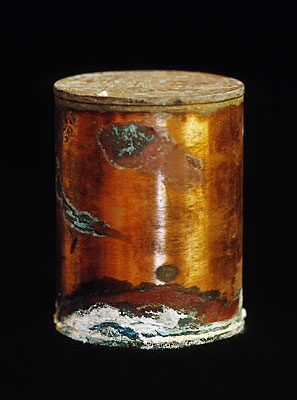
[more]
thanks to Speak, See, Remember
iran
Bush’s New Iraq Plan: Bomb Tehran
|
Critics are right to label President Bush’s new Iraq plan an “escalation,” but what was most clear from his speech announcing it is that the object of this escalation is not Iraq, but Iran.
For all the smarmy talk about the Iraq Study Group, Bush bluntly rejected its central premise that the only way the U.S. can salvage anything in Iraq is through a new political agreement both among Iraqis and their neighbors — a process that takes into account the reality that Iran has legitimate interests in Iraq (far more so, quite frankly, than the U.S. does), and envisages a process in which all stakeholders are accommodated. Instead, Bush offered familiar distortions in his description of the reason for failure thus far — al-Qaeda and Iran, were the culprits, the former stoking sectarian violence through terror attacks and the latter ostensibly supporting death squads. Anyone familiar with the current dynamics in the Middle East would have taken President Bush’s outline of the consequences of failure — “radical Islamic extremists would grow in strength and gain new recruits” and “would be in a better position to topple moderate governments,” Iran would be emboldened and al-Qaeda would have a new safe haven — as an admission of failure, since all of those consequences are already in play.
| |
[more]
Distracting Congress from the Real War Plan: Iran
|
Is the surge an orchestrated distraction from the real war plan?
A good case can be made that it is. The US Congress and media are focused on President Bush’s proposal for an increase of 20,000 US troops in Iraq, while Israel and its American neoconservative allies prepare an assault on Iran.
Commentators have expressed puzzlement over President Bush’s appointment of a US Navy admiral as commander in charge of the ground wars in Iraq and Afghanistan. The appointment makes sense only if the administration’s attention has shifted from the insurgencies to an attack on Iran.
The Bush administration has recently doubled its aircraft carrier forces and air power in the Persian Gulf. According to credible news reports, the Israeli air force has been making practice runs in preparation for an attack on Iran.
Recently, Israeli military and political leaders have described Israeli machinations to manipulate the American public and their representatives into supporting or joining an Israeli assault on Iran.
| |
[more]
Did the President Declare "Secret War" Against Syria and Iran?
|
Washington intelligence, military and foreign policy circles are abuzz today with speculation that the President, yesterday or in recent days, sent a secret Executive Order to the Secretary of Defense and to the Director of the CIA to launch military operations against Syria and Iran.
The President may have started a new secret, informal war against Syria and Iran without the consent of Congress or any broad discussion with the country.
| |
[more]
vw delvery vans
Barndoor Logo Flyers

[more]
thanks to Coudal Partners
I had a blue split window VW delivery van very much like this one in the early 1970s. I'd love to have another.
israel
Israel ON the Brink
|
Galvanized by the mounting Iranian nuclear crisis, the "survival" word and its synonymies is the talk of Israel, rising in volume from day to day and spilling to almost all sectors of Israeli life. The prevailing dark mood is epitomized by Prime Minister Olmert rush to publicly stress, for all the world to hear, that for the first time in his life he feels that there is an existential threat against the State of Israel. On this background, an analysis of the Israeli open discourse indicates that the national security paranoia is dangerously nearing "a point of no cure"
Did Israel really cross the line between legitimate strategic security concerns and existential obsession? Yes, and perilously so. How did it get there? Well, in the last two decades, sowing WMD security alarms was a rather expedient move for the Israeli politicians and media and recently it has reached an exceptional intensity. It is imperative to remember that Israel is a country with long-range strategic capabilities and as such an injection of non-rational survival fears can turn it, in a short time, into a source of global hazard.
Consider these characteristic manifestations of the Israeli frame of mind: on May last year Israel's society was swept by a wave of righteous anger. The eruption was brought about by a fabricated reporting in the Canadian newspaper the "National Post" (5/19/06) about a plot to force Iranian Jews to wear yellow badges on their cloths. In what amounted to Holocaust-leeching propaganda, cries of "Never Again" and demands for a swift Israeli response rose all over the Media. Among others, Avi Dichter, the Internal Security minister and a rising "security oriented" politician, issued a speedy public threat that those who force Jews to carry a yellow mark will be put in "caskets covered with black cloth"(5/19). In his former capacity as head of Israel Internal Security Service, Dichter used the same cool and reasoned deliberation to decide which Palestinian is worthy of "targeted prevention", namely, loosely-targeted killing.
Still, measured In Israeli standards, Dichter is thinking small. Take for example Prof. Arie Eldad, a member of the Knesset (the Israeli Parliament) and a media commentator. Eldad was among the most vocal and fear-mongering advocates of the invasion of Iraq. But he does not allow himself to be satisfied with his contribution to the liberation of hundreds of thousands Iraqis from the burden of life. He has bigger people to fry. Now a day, he finishes his opinion articles (on unrelated subjects) with the admonition: "And beside, said Old Kato, Iran must be destroyed" ("Maariv", 8/18/06, 8/25/06). "Maariv" editors find it appropriate to allow unyielding promotion of the annihilation (not merely "wiping from the map") of a nation of 70 million people.
| |
[more]
postcard art
Larger Than Life: Tall-Tale Postcards
|
Photographer Alfred Stanley Johnson, Jr. specialized in the tall-tale postcard, extolling Wisconsin's agricultural abundance through images of oversized produce and animals. Staging his friends and family to pantomime story lines, Johnson added enlarged fruits, vegetables and animals to fit the background and included titles that attributed bountiful crops to local communities. Johnson's tall-tale postcards affirmed the American myth of abundance — a myth often at odds with reality.
| |

[more]
thanks to plep
religion
The holy blitz rolls on
The Christian right is a "deeply anti-democratic movement" that gains force by exploiting Americans' fears, argues Chris Hedges. Salon talks with the former New York Times reporter about his fearless new book, "American Fascists."
|
Let's start with the title. A lot of liberals who write about the right see echoes of fascism in its rhetoric and organizing, but we tiptoe around it, because we don't want people to think that we're comparing James Dobson to Hitler or America to Weimar Germany. You, though, decided to be very bold in your comparisons to fascism.
You're right, "fascism" or "fascist" is a terribly loaded word, and it evokes a historical period, primarily that of the Nazis, and to a lesser extent Mussolini. But fascism as an ideology has generic qualities. People like Robert O. Paxton in "The Anatomy of Fascism" have tried to quantify them. Umberto Eco did it in "Five Moral Pieces," and I actually begin the book with an excerpt from Eco: "Eternal Fascism: Fourteen Ways of Looking at a Blackshirt." I think there are enough generic qualities that the group within the religious right, known as Christian Reconstructionists or dominionists, warrants the word. Does this mean that this is Nazi Germany? No. Does this mean that this is Mussolini's Italy? No. Does this mean that this is a deeply anti-democratic movement that would like to impose a totalitarian system? Yes.
You know, I come out of the church. I not only grew up in the church but graduated from seminary, and I look at this as a mass movement. I give it very little religious legitimacy, especially the extreme wing of it.
You say they would like to impose a totalitarian system. How much of a conscious goal do you think that is at the upper levels of organizing, with, say, somebody like Rod Parsley?
I think they're completely conscious of it. The level of manipulation is quite sophisticated. These people understand the medium of television, they understand the despair and brokenness of the people they appeal to, and how to manipulate them both for personal and financial gain. I look at these figures, and I would certainly throw James Dobson in there, or Pat Robertson, as really dark figures.
I think the vast majority of followers have no idea. There's an earnestness to many of the believers. I had the same experience you did -- I went in there prepared to really dislike these people and most of them just broke my heart. They're well meaning. Unfortunately, they're being manipulated and herded into a movement that's extremely dangerous. If these extreme elements actually manage to achieve power, they will horrify [their followers] in many ways. But that's true with all revolutionary movements.
| |
[more]
Michelle Goldberg, the interviewer, wrote her own book on this: Kingdom Coming: The Rise of Christian Nationalism. I'm in the hold que at my local libraray for American Fascists: The Christian Right and the War on America
architecture
chungking mansions, hong kong
by mac Kane
|
The Chungking Mansions are an example of a unique building typology that has grown out the intense urban density of Hong Kong. A simple concrete structure consisting of a two level commercial plinth and five 17 story tower blocks stacked above, it is a vernacular form of architecture that first developed in the 1960, and was repeated in similar form throughout Hong Kong.
Built in 1961, and only incrementally renovated since, the building pushes or has broken the limits of its electrical, mechanical and occupancy capacities. The Chungking mansions contain the largest number of guestrooms of any building in Hong Kong, a staggering 980 rooms scattered throughout the complex in dozens of hostels and cheap hotels. It is estimated to be home to 4000 residents and in addition to the many retail and commercial businesses it can easily contain over 10,000 occupants on a given day, virtually a self contained city. Because of the intense competition among guesthouses, It has developed a reputation as having the cheapest housing in Hong Kong, a condition that attracts a steady flow of backpackers, guest workers, and illegal immigrants to its doors.
| |

[more]
economy
The Fed’s role in the Housing Crash of ‘07
|
The American people appear to be oblivious to the economic hurricane which is expected to touchdown in late 2007. That’s when $1 trillion in ARMs (Adjustable Rate Mortgages) will “reset” triggering a massive increase in foreclosures and plunging the country into a deep recession. If energy costs continue to rise at the same time or if the dollar loses more ground, we may be rooting around in the backyard garden-plot looking for passed-over spuds and radishes.
The crisis is entirely the work of Fed Chairman, Alan Greenspan, whose “cheap money” policy caused a speculative frenzy in the real estate market which sent home prices through the stratosphere. In fact, the bubble originated in 2001 when Greenspan lowered interest rates to a meager 1% and ignited a refinancing boom as well as a sudden up-tick in home sales. Now, after 17 straight interest rate increases, the bubble is quickly losing steam and the effects are being felt from sea to shining sea. Rest assured, the sudden downturn in the housing market is just the first gust from an impending tornado. By the end of 2007, America’s match-stick economy will look like the rubble strewn landscape of New Orleans 9th Ward.
Greenspan has been the biggest player in this pre-Depression operetta. He kept the printing presses whirring along at full-tilt while the banks and mortgage lenders devised every scam imaginable to put greenbacks into the hands unqualified borrowers. ARMs, “interest-only” or “no down payment” loans etc. were all part of the creative financing boondoggle which the kept the economy sputtering along after the “dot.com” crackup in 2000.
It worked like a charm, too. Aided by the Fed’s cheap money policy, the housing market sizzled. In just 6 years the total value of real estate jumped from $11 trillion to $21 trillion! (“From 2001 through 2005, outstanding mortgage debt rose 68% from $5293 billion to $8888 billion”) It’s the biggest expansion of debt in history and it was all engineered by seductively low interest rates.
| |
[more]
Housing Bubble Bloodbath
|
“Although home ownership may be a wise choice for many people, this particular real estate bubble has been carefully engineered to lure homebuyers into circumstances detrimental to their own best interests. The bait is easy money. The trap is a modern equivalent to peonage; a lifetime spent working to pay off debt on an asset of rapidly dwindling value. Most everyone involved in the real estate bubble thus far has made at least a few dollars. But that is about to change. The bubble will burst, and when it does, the people who thought they’d be living the easy life of a landlord will soon find that what they really signed up for was the hard servitude of debt serfdom…America holds record mortgage debt in a declining housing market. Even that might first seem okay—we can just whether the storm in our nice new houses. And in fact things will be okay for homeowners who bought long ago and have seen the price of their homes double and then double again. But for more recent homeowners, who bought at the top and now face decades of payments on houses that soon will be worth less than they paid for them, serious trouble is brewing. And they are not an insignificant bunch. The problem for recent homeowners is not just that prices are falling; it’s that prices are falling even as the buyer’s total mortgage remains the same or even increases. Eventually, the price of the house will fall below what the homeowners owe, a state that economists call negative equity. They can’t sell—the declining market price won’t cover what they owe the bank—but they still have to make those (often growing) monthly payments. Their only “choice” is to cut back spending in other areas or lose the house—and everything they paid for in it—in foreclosure. Free markets are based on choice. But more and more homeowners are discovering that what they got for their money is fewer and fewer choices. A real estate boom that began with the promise of “economic freedom” will almost certainly end with a growing number of workers locked into a lifetime of debt servitude that absorbs every spare penny.”
| |
[more]
architecture
stilt houses, tai o
by mac kane
|
Tai O is a fishing village located on a small island west of Hong Kong. The island is inhabited by the Tanka people, one of the earliest tribes to settle in Hong Kong from the mainland China over a thousand years ago. The waterways are the roads to the community with boats providing the main form of transportation.
| |
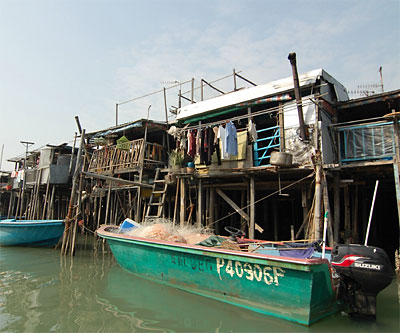
[more]
global climate change
The Warming
by Jim Kunstler
|
Everyone was walking around upstate New York delirious in their shirtsleeves on Saturday as the thermometer soared into the sixties (an all-time record for January here). The resource cornucopians were beside themselves with glee as the price of crude oil nose dived down to the mid-$50 range, proving what ninnies we peak oil alarmists are. The mustard greens we planted last July are still growing in the garden. The cat caught a garter snake. And later that evening those fluffy things in the headlights were moths, not snowflakes.
It was hard not to enjoy the end of the world. But despite all the high spirits and the roller-bladers and the kids hoisting their Ben-and-Jerry's cones, one was provoked to wonder about all the deer ticks out there enjoying an extra breeding cycle, not to mention the deer themselves, fattening up on prematurely swelling buds, and the pine bark beetles we've been hearing about up the road in the Adirondacks.
And for the really farsighted, there is the contemplation of what summer might be like. After all, if it is 67 in January, might it be 107 in July? And maybe that won't be so groovy. The electric grid is much more stressed out when all the air-conditioners are humming across the land. I'm not looking forward to Lyme disease, West Nile virus, or maybe even Dengue fever, either.
While it seems morally upright to inveigh against global warming Al Gore style, personally I don't believe there is anything we will do about it, or can do about now. The feedback loops are in motion. Something ominous is underway far greater than our measly powers can correct. Even if we started it with about two hundred years of our fossil fuel fires, there is no evidence that can just stop burning coal, oil, and methane gas on the grand scale, or that the warming would stop if we did.
| |
[more]
sidetracked
It snowed a few days ago and it's stayed cold keeping the snow on the ground and the roads icy. We expect a little more snow tonight and then some warming in the next couple of days. And hopefully no more wind for a while. I was in the local phone company office and there was another customer complaining about the power outages. He runs one of the local water districts. (We are all on well systems on the the south end of Whidbey Island.) He said that he normally has two power outages in a winter. He's had nine so far. It's hard to keep the pumps going without electricity. Here at Honeymoon Lake we have some large tanks so we can go a few days without power and there are generators to keep the water being pumped. This is the worst winter we've had for wind storms that I've seen. More climate change.
Zoe had another episode with her stomach. She had forgotten about the pain but she was able to work through it and we didn't have to make an ER run or, worse, get admitted to the hospital with an NG tube. She has been getting better but was a little tender today.

Zorki Standard and Leica IIIc
Because of the addition of the Zorki Standard to my 35mm kit made my 35mm Randefinder page even more out of date than it had been. It's updated but now I have to update the rest. It never ends.
iraq
There are no shortage of links written by very important people, but here are some words from a couple of soldiers. The first is an email sent to me tonight by my daughter Jenny. Her husband, William, is currently in Baghdad next to Sadr City.
|
Hey dad, this was written by a friend of William's and mine. He lived next door, but they moved. We still keep in contact. Anyway, I thought it was cool, and thought I'd pass it along:
"I live and breath Iraqi dirt. I smell their life and their death. Things couldn't be going better with the occupation of Iraq. I'm lying. If you watch the news, which I don't suggest, you will see we are without an answer. As of now we just try and keep the peace between two parts of a religion (Sunni and Shiite) that hate each other. Anyway I have to go keep the peace in about fifteen minutes so I should go. Later."
| |
Broken
|
I want to share with everyone here and experience that I had the other night. I was over at a friends house, and we were having a little party. After about an hour or so a limo rolls up, and I see my old friend Andy come out. Andy is in the Army, and he just returned a few weeks ago from an 18 month deployment in Iraq. I went to high school with Andy, and we played baseball together. We partied all throughout high school, and we had some great times.
I could tell right from the second I hugged him that he had changed. He was hammered. He has been hammered just about every day since he returned from Iraq, so his best friend later told me. I asked Andy how he was doing. He said "I just got back from Iraq, how the hell do you think i'm doing". Of course he's not doing good, after an 18 month tour in Iraq i'm not sure how I would be. But he kept going. "I'm broken, I've just returned from the worst experience in my life." I can't imagine what he went through, and to be honest I didn't want to ask him any specifics. Still he kept going.
"I want to go back." At that point I nearly spit out my beer. He wants to go back. I asked him why, and he responded "I killed someone, I killed many people. I've seen shit that I hope no one ever has to see in their lives. But I want to go back. I came back here after being there for 18 months and I get no respect." He was visibly shaken. It may have been the fact that he was very very drunk, but I could still tell he was shaken. "I'm on five different medications right now, they've diagnosed me with PTSD." Post traumatic stress disorder, which i'm sure just about everyone here is familiar with, is a problem plaguing the soldiers coming back from Iraq. He went on to tell me about his lack of sleep and his vivid nightmares. But what he told me next shook me to the core.
Andy told me his best friend from the service became paralyzed from the waist down after an IED attack. He returned from Iraq to his home, to his wife, and to his child. His wife left him, and took the child with him. He was left without a job, and without anyone to take care of him. He was also diagnosed with PTSD. About a week ago, Andy's friend killed himself. Andy told me "I might be next."
| |
[more]
thanks to Steve Gilliard's News Blog
Out! Now!
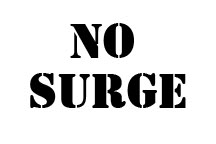
book recommendation

The Shia Revival:
How Conflicts within Islam Will Shape the Future
by Vali Nasr
This book really helps to make sense out of what is happening in the Middle East. The Shia have been shit on for 1,400 years by the Sunni. Now that the Shia are asserting themselves, the Sunni are freaking out. Our fearful leaders obviously have no clue what we stepped in the middle of. In fact, we have brought the Shia to prominence. You really have to read this. Really.
The Shia Revival
|
As nations around the world struggle with the threat of militant Islam, Vali Nasr, one of the leading scholars on the Middle East, provides us with the rare opportunity to understand the political and theological antagonisms within Islam itself. The Shia Revival is a penetrating historical account of sectarian conflicts in the Muslim world, showing that the future rests in finding a peaceful solution to the ancient rivalries between the Shias and the Sunnis.
| |
[more]
The above review has a linkg to a PDF excerpt.
Muslim Against Muslim
|
Americans may be paying more attention to Muslim conflicts now. They had better. In “The Shia Revival,” a fast-moving, engaging and ultimately unnerving book, Vali Nasr writes that wars within Islam “will shape the future.” A professor at the Naval Postgraduate School and an occasional adviser to the American government, Nasr argues that Operation Iraqi Freedom has tilled the soil for a “new” Middle East — one fueled less by the ideal of democracy than by an age-old animosity between Islam’s two major sects, the majority Sunnis and minority Shiites.
| |
[more]
iran
'The door we never opened ...'
|
Relations between the United States and Iran are as delicately poised as at any time in their troubled history since the early 1950s. Robert Fisk, the great chronicler of the Middle East at The Independent, recently wrote that it occurred to him that the final score in this unique round of the Iraq war between the US and the "forces of evil" is a "draw".
Yet one cannot be sure. Is that the final score? There may be "extra time" ahead, and if a conclusive win still eludes, a "penalty shootout" may ensue. The trouble is, no one knows the rules of the game anymore.
To be sure, the Iranian leadership has closed ranks - as it always does whenever the revolutionary heritage comes under US siege. Even for reasons of intellectual dilettantism, it becomes difficult to drive a sheet of paper between the various noisy factions and cliques and sub-cliques that usually inhabit the labyrinthine corridors of power in Tehran.
Iran senses that the United Nations Security Council resolution imposing limited sanctions over its nuclear program contains many "menacing" points, testifying to the fact that the "enemies of the Islamic Republic have plans against the country", to quote former president Akbar Hashemi Rafsanjani.
There is no inclination from any quarter of the collective leadership to exploit the Security Council resolution to score domestic political points, let alone to embarrass President Mahmud Ahmedinejad's government. There is a time for everything. The hurly-burly of the recent elections to the Expediency Council is done. No one seems to care which faction won, which one lost. Once again, the outside world's apocalyptic predictions have been belied.
| |
[more]
book recommendation

My Name Is Red
by Orhan Pamuk
Orhan Pamuk recently won the Nobel prize for literature. My Name Is Red is hard to describe in 25 words or less. It's a discussion of art, Islam, love, and change all wrapped up in a Ottoman period murder mystery. A must read.
On Orhan Pamuk's My Name Is Red
|
Orhan Pamuk's novel My Name Is Red is that rare thing: a contemporary work that can already be thought of as one of the truly essential novels. Although the Nobel Prize, which was awarded to Pamuk last week, is given not for a single book but for a body of work, there can be little doubt that My Name Is Red stands at the centre of Pamuk's oeuvre.
| |
[more]
About...My Name Is Red
|
From one of the most important and acclaimed writers at work today, a thrilling new novel—part murder mystery, part love story—set amid the perils of religious repression in sixteenth-century Istanbul.
When the Sultan commissions a great book to celebrate his royal self and his extensive dominion, he directs Enishte Effendi to assemble a cadre of the most acclaimed artists in the land. Their task: to illuminate the work in the European style. But because figurative art can be deemed an affront to Islam, this commission is a dangerous proposition indeed, and no one in the elite circle can know the full scope or nature of the project.
Panic erupts when one of the chosen miniaturists disappears, and the Sultan demands answers within three days. The only clue to the mystery—or crime?—lies in the half-finished illuminations themselves. Has an avenging angel discovered the blasphemous work? Or is a jealous contender for the hand of Enishte’s ravishing daughter, the incomparable Shekure, somehow to blame?
| |
[more]
An Excerpt from... My Name Is Red
|
Chapter 1
I Am a Corpse
I am nothing but a corpse now, a body at the bottom of a well. Although I drew my last breath long ago and my heart has stopped beating, no one, apart from that vile murderer, knows what's happened to me. As for that wretch, he felt for my pulse and listened for my breath to be sure I was dead, then kicked me in the midriff, carried me to the edge of the well, raised me up and dropped me below. As I fell, my head, which he had smashed with a stone, broke apart; my face, my forehead and cheeks, were crushed; my bones shattered, and my mouth filled with blood.
For nearly four days I have been missing: My wife and children must be searching for me; my daughter, spent from crying, must be staring fretfully at the courtyard gate. Yes, I know they're all at the window, hoping for my return.
But, are they truly waiting? I can't even be sure of that. Maybe they've gotten used to my absence-how dismal! For here, on the other side, one gets the feeling that one's former life persists. Before my birth there was infinite time, and after my death, inexhaustible time. I never thought of it before: I'd been living luminously between two eternities of darkness.
| |
[more]
My Name Is Red
From the Desk of...Orhan Pamuk
|
"My Name is Red is a novel based on classical Persian and Ottoman miniatures, The novel is full of loving descriptions of real historical miniatures. Most of them are preserved at the Topkapi Palace Museum in Istanbul. We are presenting some of them with the permission of the museum and its director, Filiz Cagman in order to illustrate the novel itself and to give you a sense of the scope and beauty of this art from the Islamic past. I have included with each image either commentary or a related passage from the novel." --Orhan Pamuk
| |
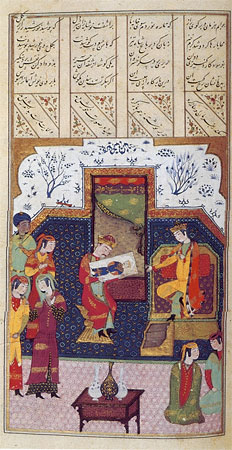
[more]
palestine
Condi’s Savage War on the Palestinians
|
In the coming weeks, Secretary of State Condoleezza Rice will cluck regretfully about the violence unfolding in the Palestinian territories as if the chaos in Gaza has as little to do with her as, say, the bizarrely warm winter weather in New York. And much of the U.S. media will concur by covering that violence as if it is part of some inevitable showdown in the preternaturally violent politics of the Palestinians. But any honest assessment will not fail to recognize that the increasingly violent conflict between Hamas and Fatah is not only a by-product of Secretary Rice’s economic siege of the Palestinians; it is the intended consequence of her savage war on the Palestinian people – a campaign of retribution and collective punishment for their audacity to elect leaders other than those deemed appropriate to U.S. agendas. Moreover, the fact that the conflict is now coming to a head is a product of Rice’s micromanagement of Palestinian President Mahmoud Abbas’s political strategy – against his own better instincts.
Rice’s siege strategy was premised on the belief that the economic torture of the entire Palestinian population would either force the Hamas government to chant the catechism of recognizing Israel-renouncing violence-abiding by previous agreements (again, Israeli leaders have to giggle at that one!) — or else, preferably, force the Palestinian electorate to recant the heresy of choosing Hamas as its government in the first place. Frustrated by the failure of this collective punishment to produce the desired results — and mindful of the need to quickly reorder Palestinian politics in order to satisfy the urgent need of the increasingly marginal Arab autocracies that Washington seeks to mobilize against Iran — she has stepped things up a notch, cajoling the hapless Abbas to take steps to toppled a government democratically elected only 11 months ago and beefing up the forces of the Fatah warlords dedicated to taking down Hamas in order to restore their own power of patronage.
| |
[more]
The above article references:
Elliot Abrams’ uncivil war
Is the Bush administration violating the law in an effort to provoke a Palestinian civil war?
|
Deputy National Security Advisor, Elliott Abrams — who Newsweek recently described as “the last neocon standing” — has had it about for some months now that the U.S. is not only not interested in dealing with Hamas, it is working to ensure its failure. In the immediate aftermath of the Hamas elections, last January, Abrams greeted a group of Palestinian businessmen in his White House office with talk of a “hard coup” against the newly-elected Hamas government — the violent overthrow of their leadership with arms supplied by the United States. While the businessmen were shocked, Abrams was adamant — the U.S. had to support Fatah with guns, ammunition and training, so that they could fight Hamas for control of the Palestinian government.
While those closest to him now concede the Abrams’ words were issued in a moment of frustration, the “hard coup” talk was hardly just talk. Over the last twelve months, the United States has supplied guns, ammunition and training to Palestinian Fatah activists to take on Hamas in the streets of Gaza and the West Bank. A large number of Fatah activists have been trained and “graduated” from two camps — one in Ramallah and one in Jericho. The supplies of rifles and ammunition, which started as a mere trickle, has now become a torrent (Haaretz reports the U.S. has designated an astounding $86.4 million for Abu Mazen’s security detail), and while the program has gone largely without notice in the American press, it is openly talked about and commented on in the Arab media — and in Israel. Thousands of rifles and bullets have been poring into Gaza and the West Bank from Egypt and Jordan, the administration’s designated allies in the program.
| |
[more]
And the above article is part of a very informative site I need to add to my blogroll:
Conflicts forum: listening to political Islam, recognizing resistance
We connect the West and the Muslim world
zorki standard
The Zorki Standard is done for now.
Friday night I was headed for my local drugstore to pick up my test roll from the Zorki Standard Rat Cam when I ran into Blaine. We talked about the little Zorki. I voiced my concern on how to cover the shutter mechanism and he suggested making a little flat pattern and cutting it out of a soft drink or beer can. I don't know why I didn't think of that. I used to draw flat patterns for a living at Boeing many years ago.
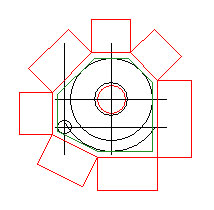
Yesterday I took some measurements off the camera and this morning I fired up my little CAD program and developed the flat pattern. I cut a practice cover out of regular paper. It all fit.

I went for the quick solution and cut the final cover out of stiffer Epson photo paper. I folded it up and covered it with gaffer's tape. It took a little fiddling. The hole had to be enlarged to 3/8" (I used a leather punch) and the legs had to be trimmed down a little. The white stripe is a piece of duct tape.

I redid the gaffer's tape on the top deck and fitted the viewfinders. Everything cleared.

I have some Tri-X arriving Tuesday from B&H. Oh yes, the test roll came out great. The shutter is working as it should. I did a couple of series at f11 and f5.6 with the 1-50 and J12 at the different distances. The focus was on for all but the 1-50 at 3 feet and f5.6. It's ready to go.
|
|
|
|















